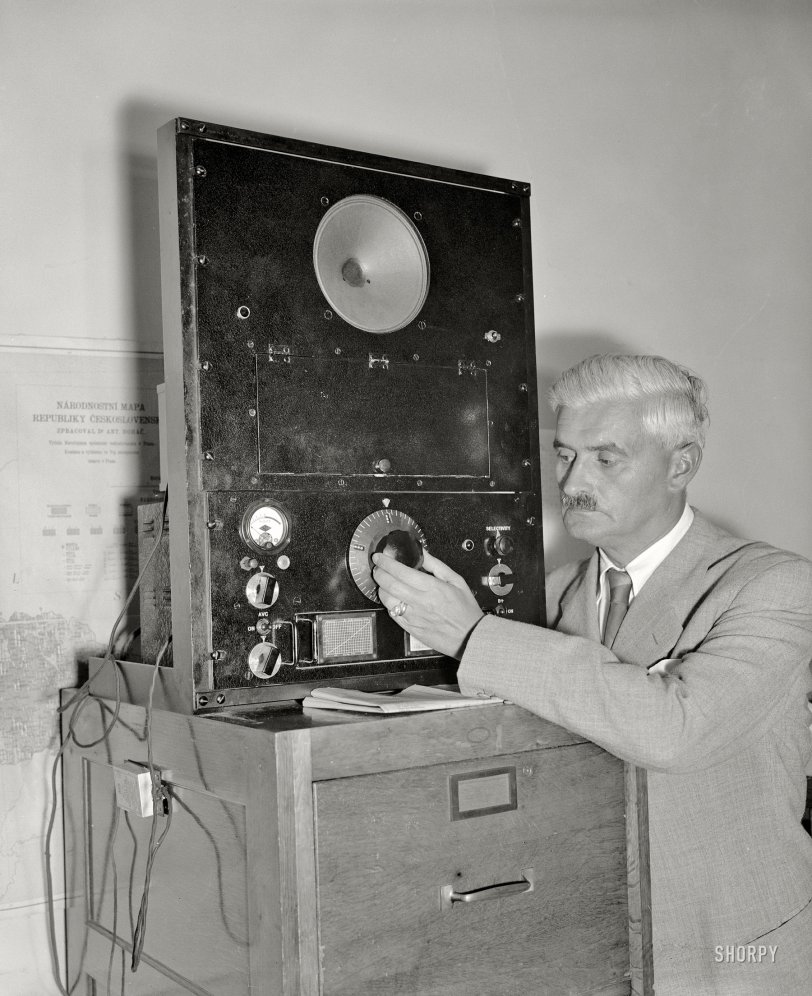


Framed or unframed, desk size to sofa size, printed by us in Arizona and Alabama since 2007. Explore now.
Shorpy is funded by you. Patreon contributors get an ad-free experience.
Learn more.

- Baldwin 62303
- Baldwin VO-1000
- Cold
- No expense spared
- Tough Guys
- Lost in Toyland
- And without gloves
- If I were a blindfolded time traveler
- Smoke Consumer Also Cooks
- Oh that stove!
- Possibly still there?
- What?!?
- $100 Reward
- Freeze Frame
- Texas Flyer wanted
- Just a Year Too Soon
- WWII -- Replacing men with women at the railroad crossing.
- Yes, Icing
- You kids drive me nuts!
- NOT An Easy Job
- I wonder
- Just add window boxes
- Icing Platform?
- Indiana Harbor Belt abides
- Freezing haze
- Corrections (for those who care)
- C&NW at Nelson
- Fallen Flags
- A dangerous job made worse
- Water Stop
Print Emporium
Hitler's Voice: 1938

September 12, 1938. Washington, D.C. "Acting Czechoslovakian Minister listens to Hitler speech. Dr. Karel Brejska, Charge d'Affaires and acting Minister in the absence of Minister Vladimir Hurban in Czechoslovakia, is pictured listening to Adolf Hitler's radio address today at the legation. He refused to comment on the speech." Harris & Ewing Collection glass negative. View full size.
Timeline
It was less than a month after this that the Munich Agreement was signed (September 29, 1938). German occupation of the Sudetenland was to be completed by October 10 - not quite a month after this photo was taken.
In November 1938, under the provisions of the First Vienna Award, Hungary occupied the southern third of Slovakia while Poland occupies a smaller section of Czechoslovakia called the Zaolzie Territory.
In March 1939, Czechoslovakia was broken up into the Protectorate of Bohemia-Moravia - a nominally autonomous region within the Greater German Reich - and the puppet Republic of Slovakia which had been relieved of about a third of its remaining territory by the Hungarians.
So roughly six months after Dr. Brejska listened to Hitler in this photo, the country he represented ceased to exist.
Czech Out the Bling
That's quite a rock on the ring finger of Dr. Brejska. It appears to be worn along with a wedding band.
Vague resemblance
The Acting Minister somewhat resembles Herr Hitler, particularly if you were to reverse the tonalities!
Stand-By Mode
That B+ on/off toggle switch was a quick way to silence the receiver if it were used in conjunction with a transmitter. If often involved simply lifting the center tap (CT) of the power transformer's high-voltage secondary winding from ground in a full-wave rectifier circuit. The vacuum tubes would remain lit, ready to go when the B+ was turned on again by grounding that CT.
Interesting timing, as I've just been (re)reading the late 1938 revision of John Gunther's "Inside Europe".
No Comment!
It's hardly surprising that Dr. Brejska declined to comment; in that infamous speech Hitler referred to the Reich coming to the rescue of Germans in the Sudetanland territory located within Chezchslovakia.
Six months later and the Czech president acceded to Hitler's demands and signed the Sudetan over to Germany.
Version 0.0
Yeah that first generation ipod really was a beast.
Green Antique Radio
I've owned a lot of National gear in my life - my first 'real' shortwave set was a venerable National NC-200 when I was 9 or 10.
This is a very early HRO - the 'drawer' with the tuning charts on it is actually a set of coils that determine the band that the radio will recieve (others are stored in the compartment under the speaker) - I've had several much-later-model HROs as well.
Power-Saving Mode:
Interesting how intently His Excellency is listening to the 'broadcast' on a device that is not powered up... the "B+ OFF-ON" switch is off, none of the indicators are lit, and the signal-strength meter is dead on the pin...
Ya's kin fool sum o' de people sum 'o de time --
Wikipedia has shot of this model, in a cabinet, and different paint: http://en.wikipedia.org/wiki/National_Radio_Company
Happy New Year (we hope).
PS: Maybe he's listening to space-echoes of early Mayan broadcasts?
Lab radio?
This looks like one of those laboratory monstrosities that the NBS has been seen here operating.
























On Shorpy:
Today’s Top 5